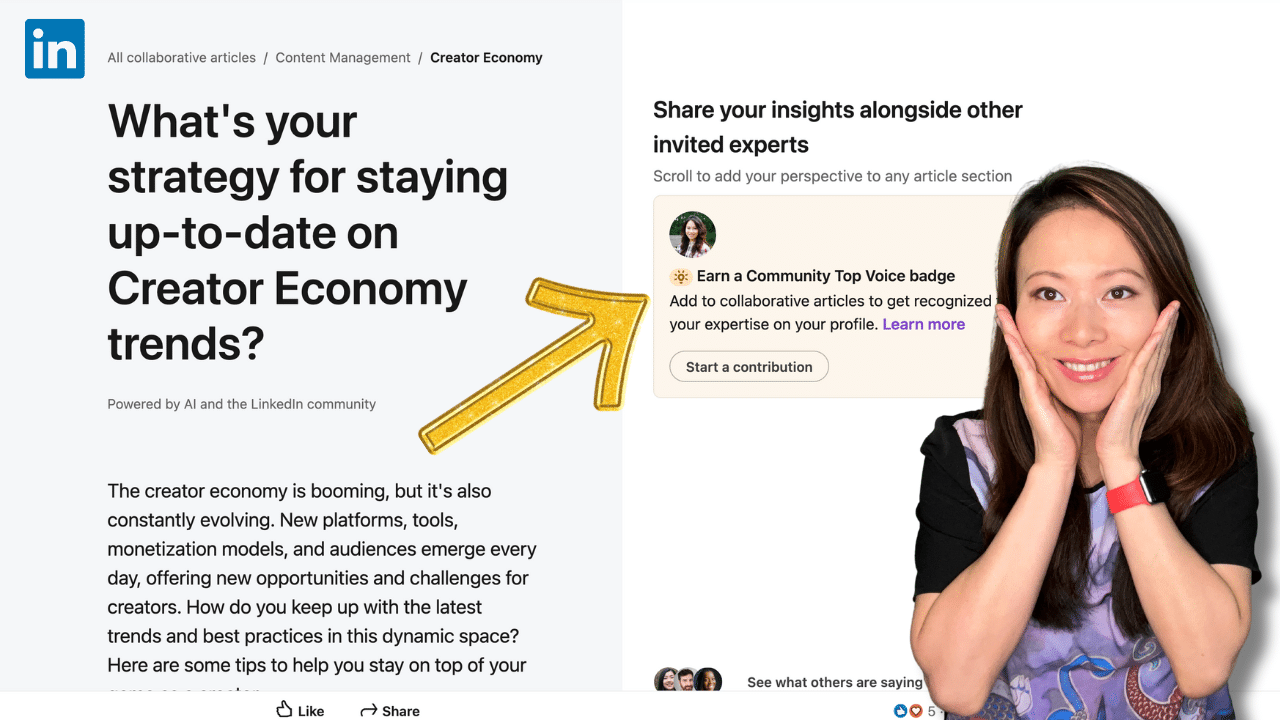LinkedIn AI: Collaborative Articles and Earn Community Top Voice Badges
In March 2023, LinkedIn introduced collaborative articles, a new type of content that LinkedIn publishes with the help of AI and LinkedIn users (LinkedIn AI). In this article, we take a closer look at what it is, whether you should care, and how you contribute to articles related to your domains.
What are Collaborative Articles?
Collaborative articles are a new way to tap into the collective knowledge of the LinkedIn community so you can learn from experts across professional topics, as well as contributing to these articles as an expert or practitioner. These articles range from the common “How do I get a promotion?” to the more specific “How do I advertise to Generation Z?”
Some of the categories I find most interesting are under categories such as Content Strategy, Creator Economy and Artificial Intelligence.
Keep reading to understand the list of categories and sub-categories available for LinkedIn Collaborative Articles.
What are the benefits of interacting and contributing to Collaborative Articles?
There’s no gate or filter as to what can contribute to an article, so everyone is welcome. This allows new creators to engage on LinkedIn and freely interact with other experts in the field.
Furthermore, these Collaborative Articles are generated and created by AI and the LinkedIn community, you would think that they capture relevant topics based on common interests. Yet they are also broad enough so that they are relevant to a larger group of readers, not just the chosen few. This is another plus in my camp as a creator. I don’t have to guess what’s trending on LinkedIn as a platform, and I can focus on what’s being surfaced based on the community’s needs.
Another benefit is the ability in gaining a Community Top Voices Badge that’s visible on your LinkedIn profile. This is a smart play by LinkedIn to attract more contributors towards Collaborative Articles.

But first, we need to understand what Top Voices are, and the different between Top Voices vs. Community Top Voices. They aren’t the same.
Top Voices vs. Community Top Voices Badges
Members on the platform have the ability to earn one of two versions of Top Voices badging on their profile, either as part of the LinkedIn Top Voices or the Community Top Voices programs.
- The blue LinkedIn Top Voice badge is invitation only, featuring senior-level experts and leaders.
- The light gold Community Top Voice badge can be earned based on making noteworthy contributions to collaborative articles on LinkedIn, and is earned for a specific skill on your profile.
How to Earn Community Top Voices Badges
Members can be identified by the light gold Community Top Voice badge.
The Community Top Voices program is separate from the invitation-only Top Voices program, which has different criteria.
You can earn a Community Top Voice badge when members find you to be one of the most noteworthy contributors to collaborative articles for a particular skill. You can earn badges for multiple skills; these will be combined into one badge on your profile. There is no limit to the number of skills for which you can earn a badge.
The Community Voice Top Badge is active for 60 days after you earn it, but may be removed at any time if you post content violates LinkedIn’s guidelines. In order to keep the badge beyond 60 days, your contributions must remain relevant, original, and additive
LinkedIn Top Voices
How to find and contribute to Collaborative Articles?
If this sounds like a worthy endeavor, it’s time to find a few articles and see if you want to add your two cents.
Step 1. Find all collaborative articles
Here https://www.linkedin.com/pulse/topics/home/

Step 2. Select from the list or articles, or filter using the Category on the right
One of the challenges with Collaborative Articles is navigating to a domain that’s relevant to our work. Therefore I gathered all the categories, sub-categories in a big table for you to more immediately find the section that might interest you.
Remember: you can contribute in more than one category or sub-category.
Step 3. Click on “Start a contribution” to add your comment to a section of the article


Step 4. Linking and Sharing
If you want to share a link to your specific contribution section (or any other’s), you can click on the three dots (…) and find a direct link. This can be quite useful to repurpose the content by sharing it as a LinkedIn post, Twitter post, or simply passing it around in text messages and emails.

Conclusion: What We Think Of LinkedIn AI Collaborative Articles
Depending on the category and subcategory, I have some some quality responses and reflections from industry experts. (It’s not a junk yard! Contributors are providing value and the space seems well moderated, if there is a moderator).
I also like the ability to contribute my original ideas, as well as replying what others have said.
However, Collaborative Articles is not a replacement for original content creation. Meaning, the content you would create and publish on LinkedIn or elsewhere as posts, blog articles, videos, etc. As with any other feature or platform we have experienced, it can go away without notice. Hence I wouldn’t bet on sharing my perspectively exclusively on LinkedIn Collaborative Articles and nowhere else. It’s part of my progress to create, engage and learn.
With that said, I see LinkedIn’s Collaborative Articles as an opportunity for content creators like us to connect with other experts in the field, to be of contribution, and to practice our writing in response to an original content – even though it’s written first by AI in this case.
Please let me know your thoughts and experiences with Collaborative Articles in the comments below. Thanks!

